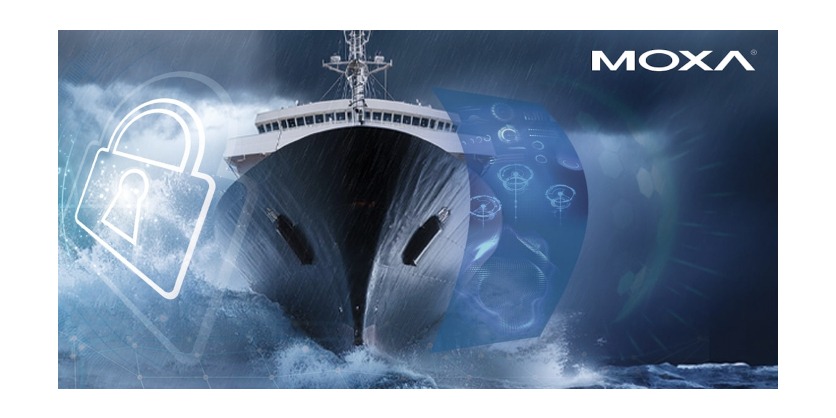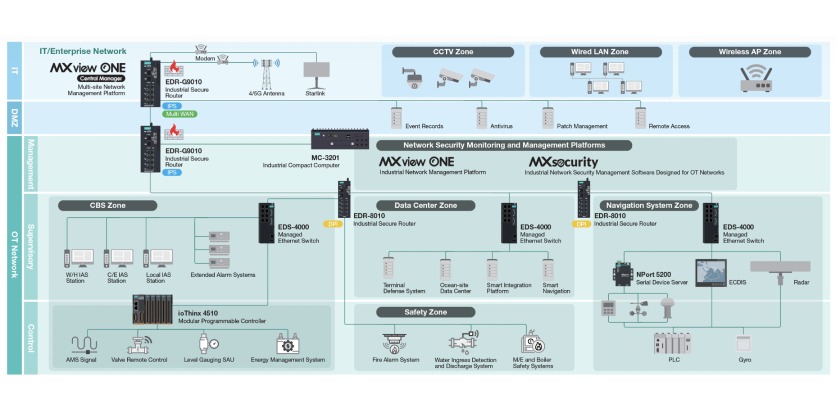MOXA Smart Maritime Solutions for Improved Cyber Resilience
April 3, 2025

Navigating the Digital Seas: Cybersecurity in the Maritime Industry
The maritime industry, while embracing innovation, faces growing cybersecurity threats. As digitalization accelerates, with advancements in cargo tracking, decarbonization, and operations, cyberattack risks increase. These attacks can disrupt operations, compromise safety, steal data, and cause significant financial losses.
What Are Maritime Cyberattacks?
These attacks target the digital systems of ships, ports, and related logistics, aiming to disrupt operations, steal sensitive information, and potentially cause physical harm.
Cyberattacks on maritime systems can have the following severe consequences:
- Operational Disruptions: Hinder daily operations, leading to delays, inefficiencies, and reputational damage.
- Safety and Security Compromises: Unauthorized access can compromise critical systems, potentially leading to accidents and endangering lives.
- Data Breaches: The theft of sensitive data, such as cargo manifests, financial records, and intellectual property, can result in significant economic losses.
- Erroneous Decision-Making: Data manipulation can lead to poor decision-making, impacting operational efficiency, safety, and financial performance.
- Physical Damage: Compromised systems can directly cause physical damage to ships or cargo, leading to costly repairs and potential environmental harm.
Why Maritime Cyberattacks Are a Growing Concern?
The International Maritime Organization (IMO) defines cyber risks as threats to technology assets that can lead to operational failures, safety breaches, or security vulnerabilities. The rapid digitalization of the maritime industry has significantly increased its exposure to these risks. Key factors contributing to this heightened risk include:
- Increased Digitalization: The widespread adoption of digital technologies for enhanced efficiency and connectivity has introduced numerous new cyber vulnerabilities.
- Complex Supply Chains: The interconnected nature of maritime operations, involving numerous actors and systems, creates a complex landscape with numerous potential entry points for cyberattacks.
- High-Value Targets: Ships and ports often transport valuable cargo and contain sensitive data, making them attractive targets for cybercriminals and even state-sponsored actors.
- Legacy Systems: Many existing maritime systems were not designed with cybersecurity in mind, leaving them highly vulnerable to modern cyber threats.
The Role of Maritime Cybersecurity
Effectively safeguarding the maritime industry necessitates a balanced integration of IT and OT security. This requires a comprehensive approach, combining traditional IT security measures with specialized tools tailored to the unique characteristics of operational technology systems.
Data: The Driving Force Behind Maritime Excellence
Cybersecurity extends beyond blocking intruders. It’s focused on protecting digital assets and data, maintaining business continuity, and remaining resilient to both external and internal threats. Protecting ship systems from physical attacks and ensuring the integrity of supporting systems are critical for maintaining overall security and operational efficiency in the maritime industry. Data-driven innovation is transforming maritime excellence, enhancing:
- Advanced route planning for efficient navigation
- Collision prevention systems for improved safety
- Energy management for smart vessels
- Port automation for reduced waiting times
- Data processing and analytics for performance optimization, predictive maintenance, and anomaly detection
Navigating the Regulatory Landscape: Compliance Matters
In a connected world, the security, safety, and reliability of maritime systems are crucial. The industry recognizes the importance of robust cybersecurity supervision to combat emerging cyber risks.
Compliance with global regulations—including IMO Resolution MSC.428(98), IEC 61162-460, ISO/IEC 27001, ISA/IEC 62443, IEC60945, and IACS Unified Requirements (URs) E26 and E27—is essential in maintaining stringent cybersecurity standards. The implementation of data-driven strategies not only improves safety and operational efficiency but also makes it essential to use certified solutions, ensuring reliable and secure data exchanges.

Moxa’s Certified High-performance Solutions Enable Your Smart Ships
As the maritime industry undergoes digital transformation by merging IT and OT, compliance with global regulations becomes essential. Data’s importance is highlighted by the rise of smart ships. Moxa sets the standard in the maritime industry with its advanced, maritime-certified solutions, including certifications from DNV, ABS, LR, NK, and BV. Its high-performance cybersecurity solutions include OT data devices, marine IPCs, networking solutions, and remote monitoring and management platforms. Moxa ensures cybersecurity across data collection, storage, transfer, and processing—providing comprehensive support for real-time data needs across maritime opperations. Moxa’s solutions enhance the entire supply chain by catering to owners, operators, and shipbuilders, effectively reducing cyber risks from individual vessels to entire fleets.
From Navigation to Maintenance—Comprehensive Solutions for Your Vessel
- Automated Rubber-tired Gantry Cranes
- Integrated Navigation Systems
- Smart Ship Remote Monitoring and Management
- Ballast Water Treatment Systems
- Integrated Automation Systems
- Ship Propulsion Control Systems
Related Story
Retrofit Your Substations with MOXA Secure IEC 61850 Gateways
Integrating legacy power systems with IEC 61850 communication networks can be challenging due to the diverse industrial protocols used at field sites. Additionally, incorporating these systems into modern networks introduces significant security risks. Moxa’s MGate 5119 Series IEC 61850 gateways are designed to bridge this gap by supporting key power industry protocols such as Modbus, DNP3, IEC 60870-5-101/104, and IEC 61850.




